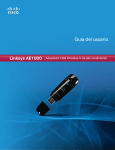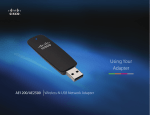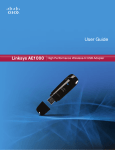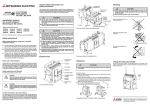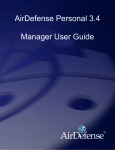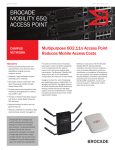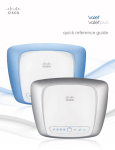Download Linksys AE1000
Transcript
User Guide Linksys AE1000 High Performance Wireless-N USB Adapter Table of Contents Linksys AE1000 Contents Chapter 1: Product Overview 1 LED . . . . . . . . . . . . . . . . . . . . . . . . . . . . . . . . . . . . . . . . . . . . . . . . . . . . . . . 1 Chapter 2: Installation 2 Installation . . . . . . . . . . . . . . . . . . . . . . . . . . . . . . . . . . . . . . . . . . . . . . . . . . 2 Chapter 3: Wireless Network Configuration 4 Windows 7 . . . . . . . . . . . . . . . . . . . . . . . . . . . . . . . . . . . . . . . . . . . . . . . . . . 4 Windows Vista . . . . . . . . . . . . . . . . . . . . . . . . . . . . . . . . . . . . . . . . . . . . . . . . 5 Windows XP . . . . . . . . . . . . . . . . . . . . . . . . . . . . . . . . . . . . . . . . . . . . . . . . . 7 Appendix A: Troubleshooting 8 Appendix B: Specifications 9 High Performance Wireless-N USB Adapter ii Linksys AE1000 Chapter 1: Product Overview Thank you for choosing the Linksys AE1000 High Performance Wireless-N USB Adapter. Using the latest wireless networking technology, the Adapter adds or upgrades wireless connectivity on your Windows-based desktop or laptop computer. To help protect your data and privacy, you can use Wi-Fi Protected Access 2 (WPA2) encryption to protect your wireless connection. Chapter 1: Product Overview USB Extension Base The Adapter comes attached to its USB Extension Base. Using the Adapter in its Base may often improve wireless signal performance, especially with desktop computers that may be located under desks or tabletops. To use the USB Extension Base, make sure the Adapter is connected to the Base, and then connect the USB Extension Base to a USB port on your computer or laptop. LED Link (Blue) The LED flashes when there is wireless network activity. Storing the Cap When the Adapter is plugged into the USB Extension Base or your computer’s USB port, you can store the cap by attaching it to the Adapter. To store the cap, push it onto the top of the Adapter until it fits snugly. High Performance Wireless-N USB Adapter 1 Chapter 2: Installation Linksys AE1000 Chapter 2: Installation This chapter describes the procedure for installing the Adapter. 3. Read the Software End User License Agreement. To accept the agreement and continue with the installation, click Next. Installation To install the Adapter: 1. Insert the CD into your CD-ROM drive. License Agreement 4. Insert the Adapter into an available USB port on your computer. Insert CD 2. Click Set up your Linksys Adapter. DVD/CD-RW Drive (E:) Linksys Router Setup Always do this for software and games: AutoPlay DVD/CD-RW Drive (E:) Linksys Adapter Setup Install or run program Always do this for software and games: Install or run program Set up your Linksys Adapter Published by Cisco Consumer Products LLC General options Open folder to view files using Windows Explorer Set up your Linksys Adapter Published by Cisco Consumer Products LLC General options Install Linksys AE1000 View more AutoPlay options in Control Panel Open folder to view files using Windows Explorer Speed up my system using Windows ReadyBoost Set AutoPlay defaults in Control Panel Set up Your Linksys Adapter If you do not see this, access setup on the CD directly. To do so, perform the following steps for your specific operating system: Windows 7 5. An Easy Setup Key helps you quickly connect to your wireless hotspot or router. If you do not have an Easy Setup Key, select No, I don’t have an Easy Setup Key. If you have an Easy Setup Key, select Yes, I have an Easy Setup Key. Click Next. NOTE: Cisco Valet wireless hotspots come with an Easy Setup Key. Cisco Valet wireless hotspots and some Linksys routers also let you create one from your own USB flash drive. (You do not need an Easy Setup Key to complete installation.) a. Go to Start > Computer. b. Double-click your CD-ROM drive. Windows Vista a. Go to Start > Computer. b. Double-click your CD-ROM drive. Windows XP a. Go to Start > My Computer and select your CD‑ROM drive. b. Double-click Setup.exe. Do You Have an Easy Setup Key? If you do not have an Easy Setup Key, go to step 6. If you have an Easy Setup Key, go to step 8. High Performance Wireless-N USB Adapter 2 Linksys AE1000 6. A list of available wireless networks appears. Select your network. Click Next. Chapter 2: Installation 9. The installation is complete. Click Close. You are Now Connected to Your Wireless Network Connect to a Wireless Network 7. If your network does not use wireless security, go to step 9. If your network uses wireless security, enter the wireless password for your type of security: •• Wired Equivalent Privacy (WEP): Enter the WEP key. •• Wi-Fi Protected Access (WPA/WPA2): Enter the passphrase (also known as a pre‑shared key). NOTE: If you have any problems during the installation process, refer to the Frequently Asked Questions in the setup software, or use a computer with an active Internet connection to visit www.linksys.com/support. Click Next. Go to step 9. Enter the Wireless Password 8. Follow the on-screen prompts to use your Easy Setup Key. Click Next. Insert your Easy Setup Key High Performance Wireless-N USB Adapter 3 Linksys AE1000 Chapter 3: Wireless Network Configuration Chapter 3: Wireless Network Configuration 2. Select your network, and then click Connect. To configure the Adapter’s wireless connection settings, use a wireless network configuration utility. If you have installed such a utility on your computer, or if your computer came with one already installed, refer to that utility’s documentation for instructions on use. Otherwise, follow the instructions in the appropriate section below to use your operating system’s built-in utility: Windows 7, page 4, Windows Vista, page 5, or Windows XP, page 7. Windows 7 After you have installed the Adapter, the Wireless Network Configuration utility icon appears on your computer’s system tray. Wireless Network Configuration Utility Icon Select Network 3. If your network does not use wireless security, go to step 5. 4. Enter the security key, Wired Equivalent Privacy (WEP) key, or Wi-Fi Protected Access (WPA/WPA2) passphrase (also known as a pre‑shared key), depending on your type of security. Click OK. (If you do not see the icon, click the Show hidden icons arrow in the system tray.) When your mouse pointer hovers over the icon, the status information of your wireless connection appears. Wireless Connection Status New Wireless Connection To connect to a different wireless network: 1. Click the Wireless Network Configuration utility icon. A list of available wireless networks appears. Secured Network 5. This screen appears while the Adapter connects to your network. Do not cancel, unless you want to end the connection. Connecting to Network NOTE: For help with the Wireless Network Configuration utility, refer to Help and Support. > Help and Support. Click Start Available Wireless Networks High Performance Wireless-N USB Adapter Your computer is now connected to your wireless network. 4 Chapter 3: Wireless Network Configuration Linksys AE1000 Windows Vista 3. Select your network, and then click Connect. After you have installed the Adapter, the Wireless Network Configuration utility icon appears on your computer’s system tray. Wireless Network Configuration Utility Icon When your mouse pointer hovers over the icon, the status information of your wireless connection appears. Select Network 4. If your network uses wireless security, go to step 5. If your network does not use wireless security, this screen appears. To connect to your unsecured network, click Connect Anyway and go to step 7. Wireless Connection Status New Wireless Connection To connect to a different wireless network: 1. Right-click the Wireless Network Configuration utility icon. 2. Click Connect to a network. Unsecured Network Utility Menu 5. Enter the security key, Wired Equivalent Privacy (WEP) key, or Wi-Fi Protected Access (WPA/WPA2) passphrase (also known as a pre‑shared key), depending on your type of security. Click Connect. Secured Network High Performance Wireless-N USB Adapter 5 Linksys AE1000 6. This screen appears while the Adapter connects to your network. Do not cancel, unless you want to end the installation. Chapter 3: Wireless Network Configuration 9. This screen varies according to the selected location. Click Close. Network Settings Saved Connecting to Network 7. This screen appears when you are connected to your network. Select Save this network, if you want to save your settings. Click Close. NOTE: For help with the Wireless Network Configuration utility, refer to Help and Support. > Help and Support. Click Start Your computer is now connected to your wireless network. Connected to Network 8. The Set Network Location screen may appear. This screen helps apply the correct settings for your type of location. Select Home, Work, or Public location. Select Network Location High Performance Wireless-N USB Adapter 6 Linksys AE1000 Windows XP After you have installed the Adapter, the Windows XP Wireless Zero Configuration Utility icon appears on your computer’s system tray. Chapter 3: Wireless Network Configuration 4. If your network uses Wired Equivalent Privacy (WEP) wireless security, enter the WEP Key in the Network key and Confirm network key fields. If your network uses Wi-Fi Protected Access (WPA/WPA2) wireless security, enter the passphrase in the Network key and Confirm network key fields. Click Connect. Wireless Zero Configuration Utility Icon When your mouse pointer hovers over the icon, the status information of your wireless connection appears. Wireless Security Wireless Connection Status New Wireless Connection 1. Right-click the Windows XP Wireless Zero Configuration icon in your computer’s system tray, and then select View Available Wireless Networks. 2. A window displays the available wireless networks. Select the network that you want and click Connect. If the network uses wireless security, go to step 4. Otherwise, continue to step 3. Available Wireless Network 3. Click Connect Anyway to connect the Adapter to your unsecured network, and then go to step 5. NOTE: Windows XP Wireless Zero Configuration does not support the use of a WEP passphrase. Enter the exact WEP key used by your wireless router or access point. NOTE: If your network is using WPA2 security, make sure that you have installed the Update for Windows XP (KB893357), available at www.microsoft.com. 5. Your wireless network will appear as Connected when your connection is active. Wireless Network Connection NOTE: For help with the Wireless Network Configuration utility, refer to Help and Support. Click Start > Help and Support. Enter wireless in the Search field, and then press Enter. Your computer is now connected to your wireless network. No Wireless Security High Performance Wireless-N USB Adapter 7 Linksys AE1000 Appendix A: Troubleshooting Appendix A: Troubleshooting Your computer does not recognize the Adapter. Make sure that the Adapter is properly inserted into your computer’s USB slot and/or USB Extension Base. The Adapter does not work properly. Remove the Adapter, and then reinsert it into the computer’s USB slot. Your computer cannot communicate with the other computers on your wireless network. 1. Make sure that the computers are powered on. 2. Make sure that the Adapter is configured with the same Wireless Network Name (also called the SSID or Service Set Identifier) and wireless security settings as the other computers on your wireless network. WEB: If your questions are not addressed here, refer to our AE1000 support section on the web, www.linksys.com/support/AE1000 High Performance Wireless-N USB Adapter 8 Appendix B: Specifications Linksys AE1000 Appendix B: Specifications Security Features WEP, WPA & WPA2 Personal, WPA & WPA2 Enterprise Model Name Linksys AE1000 Security Key Bits Up to 128-Bit Encryption Description High Performance Wireless-N USB Adapter Model Number AE1000 Standards 802.11a, 802.11b, 802.11g, 802.11n OS Requirements Up-to-date Windows XP, Windows Vista, Windows Vista 64-bit Edition, or Windows 7 LEDs Link/Act Number of Antennas2 Internal Antennas Transmitted Power 2.4 GHz @ 11 Mbps data rate: 18 dBm ± 1.5 dBm 2.4 GHz @ 54 Mbps data rate: 14 dBm ± 1.5 dBm 5 GHz @ 54Mbps data rate: 12 dBm ± 1.5 dBm 2.4 GHz, 11N (MCS0, HT20/40): 18 dBm ± 1.5 dBm 2.4 GHz, 11N (MCS8, HT20/40): 18 dBm ± 1.5 dBm 2.4 GHz, 11N (MCS15, HT20/40): 12 dBm ± 1.5 dBm 5 GHz, 11N (MCS0, HT20/40): 16 dBm ± 1.5 dBm 5 GHz, 11N (MCS8, HT20/40): 16 dBm ± 1.5 dBm 5 GHz, 11N (MCS15, HT20/40): 10 dBm ± 1.5 dBm Receive Sensitivity -84 dBm @11 Mbps -70 dBm @54 Mbps -83 dBm @2.4 GHz/5 GHz, MCS0, HT20 -80 dBm @2.4 GHz/5 GHz, MCS0, HT40 -83 dBm @2.4 GHz/5 GHz, MCS8, HT20 -80 dBm @2.4 GHz/5 GHz, MCS8, HT40 -65 dBm @2.4 GHz/5 GHz, MCS15, HT20 -62 dBm @2.4 GHz/5 GHz, MCS15, HT40 Environmental Dimensions 3.15" x 1.00" x 0.49" (79.9 x 25.4 x 12.4 mm) Weight 0.39 oz (11 g) Certification FCC, CE, IC, UL, RoHS, WEEE, IDA, C-Tick, Wi-Fi A/B/G/N Operating Temp. 32 to 104ºF (0 to 40ºC) Storage Temp. -4 to 158ºF (–20 to 70ºC) Operating Humidity 10 to 85% Noncondensing Storage Humidity 5 to 90% Noncondensing Specifications are subject to change without notice. Antenna Gain in dBi 802.11a: 5 GHz => 4 dBi 802.11g: 2.4 GHz => TX0: 0.5 dBi, TX1: 1.4 dBi Power Consumption TX (2.4 GHz): 330 mA, HT20; 340 mA HT40 at 5V TX (5 GHz): 400 mA, HT20; 430 mA HT40 at 5V RX (2.4 GHz): 140 mA, HT20; 160 mA HT40 at 5V RX (5 GHz): 150 mA, HT20; 180 mA HT40 at 5V Standby: 150 mA Radio Off: 20 mA High Performance Wireless-N USB Adapter 10052710B-AI 9 www.linksys.com/support Cisco, the Cisco logo, and Linksys are trademarks or registered trademarks of Cisco and/or its affiliates in the United States and certain other countries. All other trademarks mentioned in this document or website are the property of their respective owners. © 2010 Cisco and/or its affiliates. All rights reserved.












